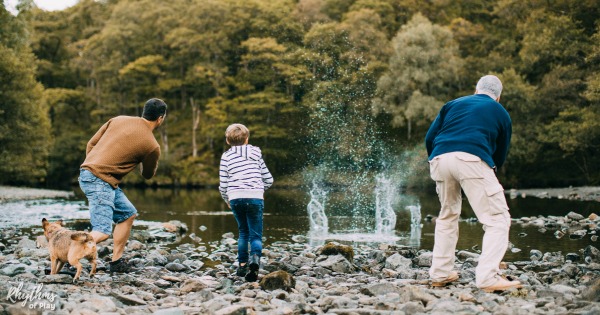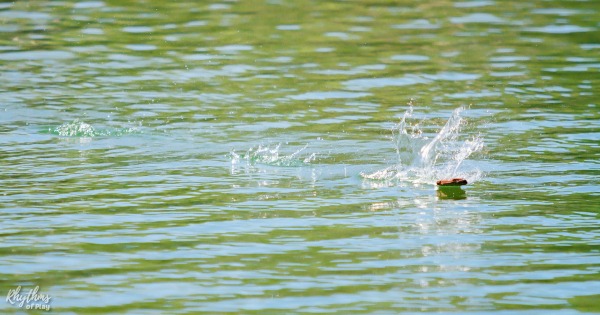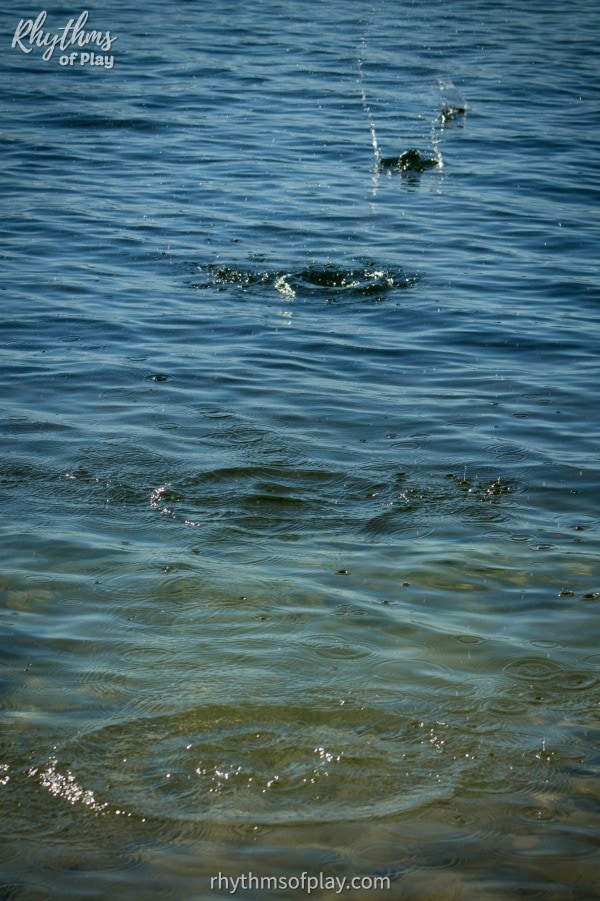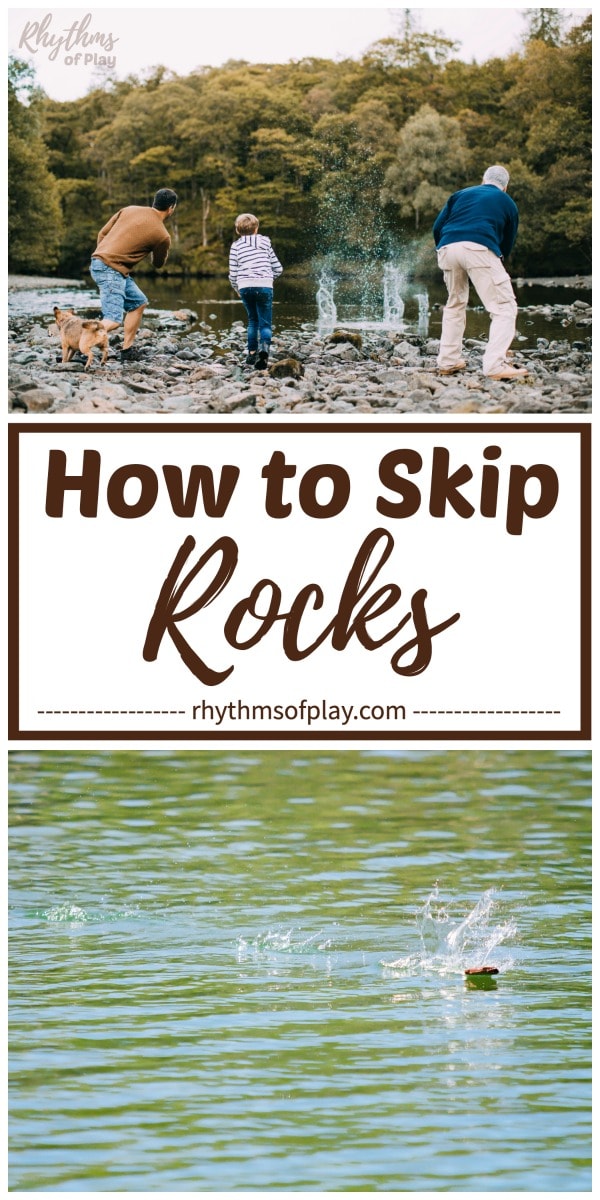Have you ever wondered what skipping rocks means, what it means to skip rocks, what causes a rock to skip, or why rocks skip on water? We’ve got the answers: Skipping or skimming stones, rocks, and pebbles is a fun outdoor STEM activity for kids and adults. Learn how to skip a rock and have all your questions answered below! (First published February 18, 2020; this post is regularly updated and republished to improve the content.)
Skipping stones, stone skipping, skipping rocks, or stone skimming, are phrases that mean essentially the same thing. They each refer to the art of throwing a smooth flat stone at a slight angle across a body of water to make it bounce or skip off its surface as many times as possible before sinking. In the following sections, learn everything you need to know about how to skip rocks, a little bit about the basic physics of stone skipping, and a few stone-skipping math games. You might also enjoy stone stacking and painting rocks.
Why are there so many names for rock skipping?
Because rock skipping is a pastime enjoyed worldwide, it is known by many names. In England, stone skipping is called ‘ducks and drakes,” in Ireland, it is known as “stone skiffing,” in Denmark, it’s called “smutting,” in France, it is named “ricochet,” and most other languages around the world have a unique name for skipping stones.
Why do people skip rocks?
Skipping rocks is a classic outdoor activity for young and old alike. The primary goal is to see the number of times they can make the stone skip or bounce off the water’s surface before sinking. But skimming stones is not just child’s play; it is a highly competitive outdoor activity with thousands of participants, several fun competitive events, and raving fans everywhere.
Where do people skip rocks?
Anywhere there is a body of water and rocks is a good place to skip stones. This makes lakes, ponds, rivers, creeks, and the ocean or sea a great choice for rock-skipping fun.
Where is the best place to skip rocks?
The best place for rock skipping is a large body of water with a smooth, flat, or calm surface and plenty of stones nearby. Lakes and ponds are ideal because the water is often calmer than the moving water found in oceans, rivers, and creeks. Oceans and rivers have waves, currents, and rough-moving water, which makes skipping stones across the water’s surface more challenging, but it can still be done. However, you can occasionally find optimal conditions for rock skipping at an ocean, river, or creek when the water is calm and flat.
How to Skip Rocks and Stones
Learn how to skip rocks and skim pebbles with the step-by-step instructions below. These simple stone skimming tips make it easy to teach children, from toddlers to teens and adults, how to skip a stone across a surface of water.
1. Find a large body of calm water with smooth stones or numerous rocks nearby to practice skipping stones.
- Look for a flat or calm body of water with a smooth surface to skip stones.
- Lake and pond water usually has a smooth surface area, while oceans and rivers have waves, currents, and rough-moving water, making skipping stones across the water’s surface more challenging.
- You can skip stones in rough moving water, and we encourage you to try it, but it’s not as easy.
2. Search for and select smooth flat stones of different shapes and sizes for rock skipping.
- The best skipping stones tend to be those that are flat, smooth, fit in the palm of your hand and are easy to toss with a slight flick of the wrist.
- Some people prefer a large flat rock, others like triangular stones, while others prefer a smaller smooth stone for skimming.
- Scroll down to see the world record holder, Kurt Steiner, share what he thinks are the best rocks for skipping.
3. Demonstrate how to properly grip a rock to skip stones Across the water.
- There are several ways to grip a stone to make it skip. The most common way is to hook the pointer finger around the stone while balancing the rock between the thumb and middle finger.
- Hold the stone’s smooth, flat, or slightly concave side downward with the more convex or jagged edge turned upward.
4. Teach participants how to throw and release a rock or stone across flat water to skip it.
- Show children (and adults) how to throw a stone with enough angular velocity to fight gravity and skip it across the water.
- The photograph above shows a young boy bending his knees to get a good backswing before throwing a skipping rock.
- Quickly whip your arm forward and release the rock when it comes across your body so it’s parallel to the water.
- Snap or flick your wrist forward at the end of the throw to spin the rock so it bounces off the surface.
- Ensure you throw the stone with a low sidearm swing at an optimal angle to get maximum skips.
- Throw and release the stone at a 20-degree angle of attack toward the water’s surface for best results.
- The idea is to skim the water’s surface with the slightly angled and spinning flat side of the stone at a high horizontal velocity or speed to make it bounce, ricochet, or skip across the water, as shown in the photograph below.
The Science of Skipping Stones
Stone skimming is a STEM activity that kids and adults will enjoy! Toddlers, preschoolers, and kids of all ages can learn how to skip a rock or a stone with the tips listed above and a little knowledge of the physics of stone-throwing and the scientific principles at work.
Related: Sorting and Classifying Rocks
How Does Stone Skipping Work?
Several forces work together to cause a rock to skip across the water’s surface, with gravity and lift being the primary actions at play. Gravity pulls the stone down while lift pushes it back up each time it hits the water’s surface. If the lift force is greater than the force of gravity, then the rock will bounce up. Conversely, the stone will sink with insufficient lift relative to gravity.
Why Do Rocks Skip on Water?
When you throw a rock with enough velocity and spin at just the right angle (angular momentum), it will make a small wave pushing away from the stone as it hits the water’s surface. And when the velocity of the stone exceeds the lift force of the wave it creates, the rock will repeatedly rise and skip or bounce off the water’s surface.
How does a stone skip across the water?
The shape and speed of the rock, the amount of spin it has, and the angle of the throw will each influence the amount of lift the stone will have and its ability to skip across the water. When each of these conditions is optimal, the number of times a stone will skip across the water will increase.
What is the best angle to skip a stone?
The best angle to skip a stone is 20 degrees. Throw a rock at a 20-degree angle of attack with respect to the water’s surface for best results.
How do you get more skips with a rock?
The angle of the toss, velocity or speed of the throw, and the amount of spin (gyroscopic stabilization), are each essential to stone-skipping success, with the angle of attack being the most important. The optimal angle to throw a stone for maximum skips is 20 degrees with respect to the water’s surface. A fast-moving spinning rock can help hold the 20-degree angle of attack so that the lift force can remain strong enough to cause the rock to bounce on the water and ricochet multiple times, as shown in the photograph below.
When a cannonball, stone, or water-skipping toy with sufficient speed hits a water surface at an angle, it forms a cavity that fills with ambient air… In a successful skip, the object planes along the front of the cavity and is ultimately propelled off the surface by a pressure-driven hydrodynamic force.
Physics Today
What kind of rock is best for skipping or skimming stones, and What makes a good skipping rock?
The best skipping stones are uniformly thick and smooth or flat on both sides. Some people enjoy a smaller rock to skip, others like skipping triangular stones, while others prefer big flat disks about the size of the palm of your hand.
The stone-skipping world record holder for the most skips across the surface of a body of water, Kurt Steiner, shares what he thinks are the best-skipping stones and why, along with several more of his stone-skimming tips in the video below.
Rock Skipping World Records
Learn who holds the Guinness World Record for the greatest distance skimmed and the record holder of the most skips with a rock below.
Related: Shadow Sidewalk Chalk STEAM
What is the World Record for skipping Rocks on water?
The Guinness World Record for the furthest distance skimmed using natural stone is 121.8m for men, established by Dougie Isaacs (Scotland), and 52.5m for women, thrown by Nina Luginbuhl (Switzerland). These records happened on May 28, 2018, at a tournament in Abernant Lake, Llanwrtyd Wells, Powys, Wales. (source)
Who holds the record for most rock skips?
Kurt “Mountian Man” Steiner holds the stone skipping world record for the maximum number of skips. His winning stone toss had a total of 88 skips at the time of this update. In other words, he holds the Guinness World Record for “the most consecutive skips across the surface of the water.” He achieved this impressive title in the Allegheny National Forrest at a competition against several tough competitors on September 6, 2013, at Red Bridge, Pennsylvania. The video below shows the throw that helped Steiner win the world stone skimming championship and secure the world record stone skipping title.
Related: Rock Balancing Stone Stacking Art
Turn the Art of Stone Skipping into a Math Game for Kids
Have a stone-skipping competition with any of these fun rock-throwing game ideas for kids and adults. First, teach everyone how to skip a rock with the step-by-step how-to instructions above. Next, play a simple stone-skipping game!
Invite players to count how many times they can skip the stone or rock across the water before it sinks. Or, invite players to do a little more math, other than counting, while they skip stones across the water’s surface.
There are many ways to make this an easy outdoor homeschool math lesson. Young children can work on counting rocks and counting the number of times a rock skips. To increase the challenge, invite children to throw ten rocks and count the number of times each stone skips. Next, ask them to average the number of times they skipped a stone across the water.
Or, create teams and average each person’s rock-skipping record with the other team members for the day. The team with the highest average wins!
Related: Outdoor Learning and Nature Activities for Kids
Rock Skipping: An Outdoor Activity for All Ages
Skipping, or skimming, stones and rocks is a classic outdoor activity for children and adults. We hope you enjoyed learning about the art and science of rock skipping and the world record score to beat!
I don’t think I will ever be able to skip a rock 88 times across the water. But it’s fun to know that much more than that is possible–wow! Please share your best personal stone-skipping record in the comments below.
We hope you have enjoyed learning how to skip a rock and the scientific principles behind skipping stones. You might also enjoy the rock activities for kids (and adults) on the list below. Learn more about us HERE–> About Rhythms of Play.
More Rock Activities for Kids
- Rock Painting Ideas
- Sorting and Classifying Rocks
- Rock Balancing Stone Stacking ART
- Stone and Shell Owl Craft
- Fairy House Painted Rocks
















Leave a Comment